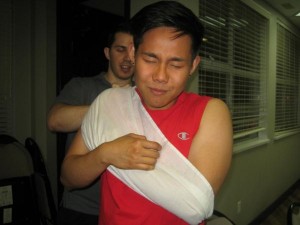Delayed complications of bone healing such as delayed union occurs when healing does not occur at a normal rate for the location and type of fracture. Delayed union may be associated with distraction (pulling apart) of bone fragments, systemic or local infection, poor nutrition or chronic morbidity (diabetes mellitus, autoimmune disease). However, despite the delay in fracture healing, the fractured bone eventually heals.
Other types of delayed complications of bone healing similar to delayed union is nonunion wherein there is a failure of the ends of the fractured ends of a fractured bone to unite in normal alignment while malunion is a similar yet distinct fracture complication wherein there is a failure of the ends of a fractured bone to unite in normal alignment.
Factors generally contributing to delayed complications of bone healing
In all instances, the patient may experience persistent pain and discomfort as well as abnormal movement of the fracture site. Factors that contribute to delayed union, nonunion and malunion include infection at the fracture site, the interposition of tissue between the bone ends, inadequate immobilization or manipulation that disrupts callus formation, excessive space between bone fragments (bone gaps), limited bone contact and impaired blood supply resulting in avascular necrosis of the bone.
Medical management for delayed complications of bone healing
The physician normally treats delayed complications of bone healing such as nonunion of bone with internal fixation, bone grafting, electrical bone stimulation or a combination of these therapies. Internal fixation stabilizes the bone fragments making sure there is adequate bone contact for proper healing to occur. Bone grafts provide for osteogenesis (formation of new bone). Grafted bone undergoes a reconstructive process that results in the gradual replacement of graft with new bone. During surgery the bone fragments are trimmed, infection is removed, and bone graft is placed in the bone defect. What generally happens in bone graft is it fills the bone gap, provides a lattice structure for invasion by bone cells and actively promote bone growth.
Nursing care management for delayed complications of bone healing
The patient experiencing any of the three major classifications of delayed complications such as delayed union, nonunion and malunion almost certainly have an extended time in fracture treatment and will become overly frustrated with the prolonged and extended period of therapy and recovery process. The nurse charged with the care of patients who are experiencing delayed complications in fracture healing should not only provide for basic care requirements in maintaining

safety and increasing patient comfort but more importantly provide emotional support and encouragement. During the healing process, the orthopedic surgeon normally would evaluate the progression of bone healing with periodic x-rays and the nurses’ role should be centered in updating the patient’s condition as well as making sure the patient’s concerns and questions are properly addressed and relayed between the members of the health care team.
Nursing care for patients with bone graft includes pain management, monitoring the patient for signs of infection at the harvest and recipient sites and patient education. Moreover, the nurse needs to reinforce information concerning mobilization restrictions, non-weight bearing exercises, wound care, signs of infection to immediately report and follow-up care as provided for by the surgeon in order to avoid a relapse of delayed complications of bone healing.